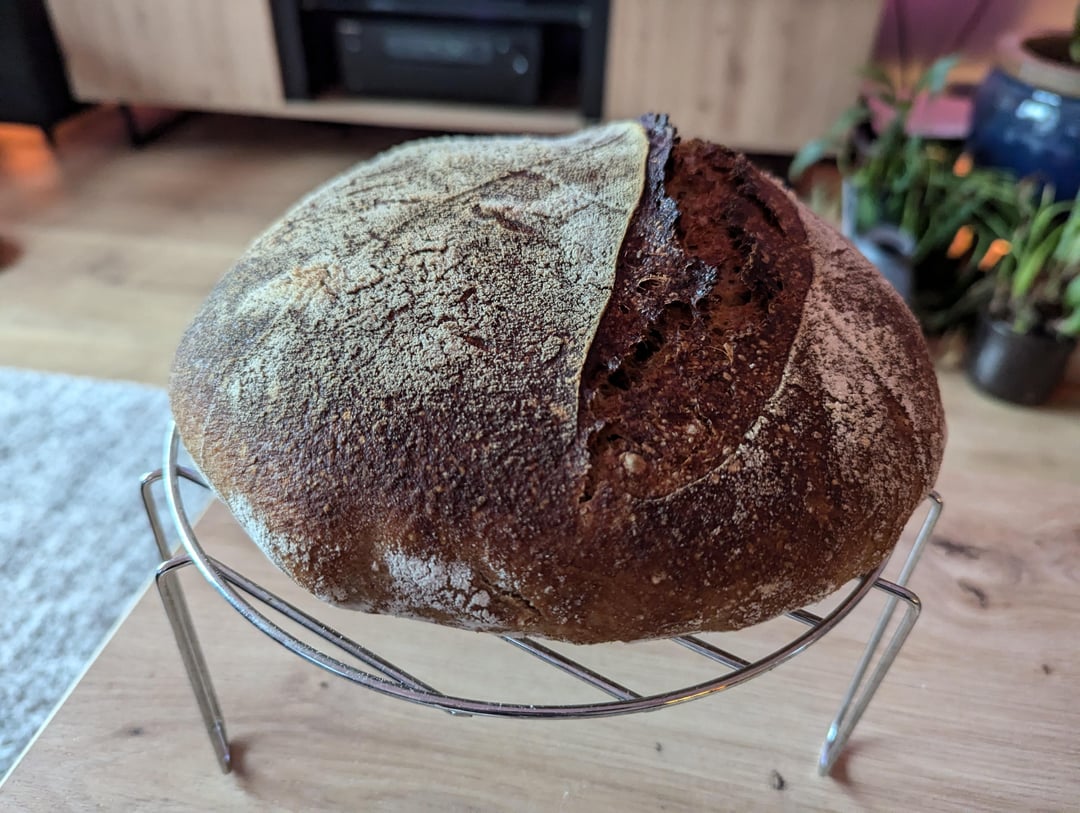
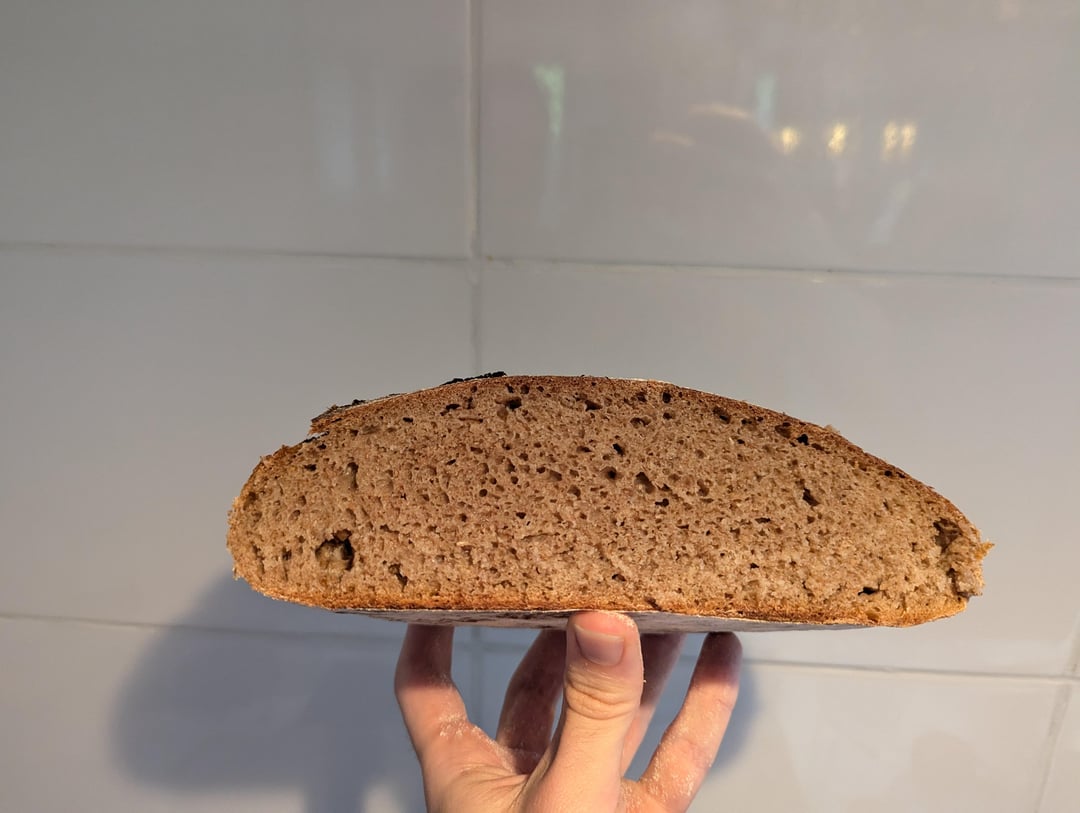
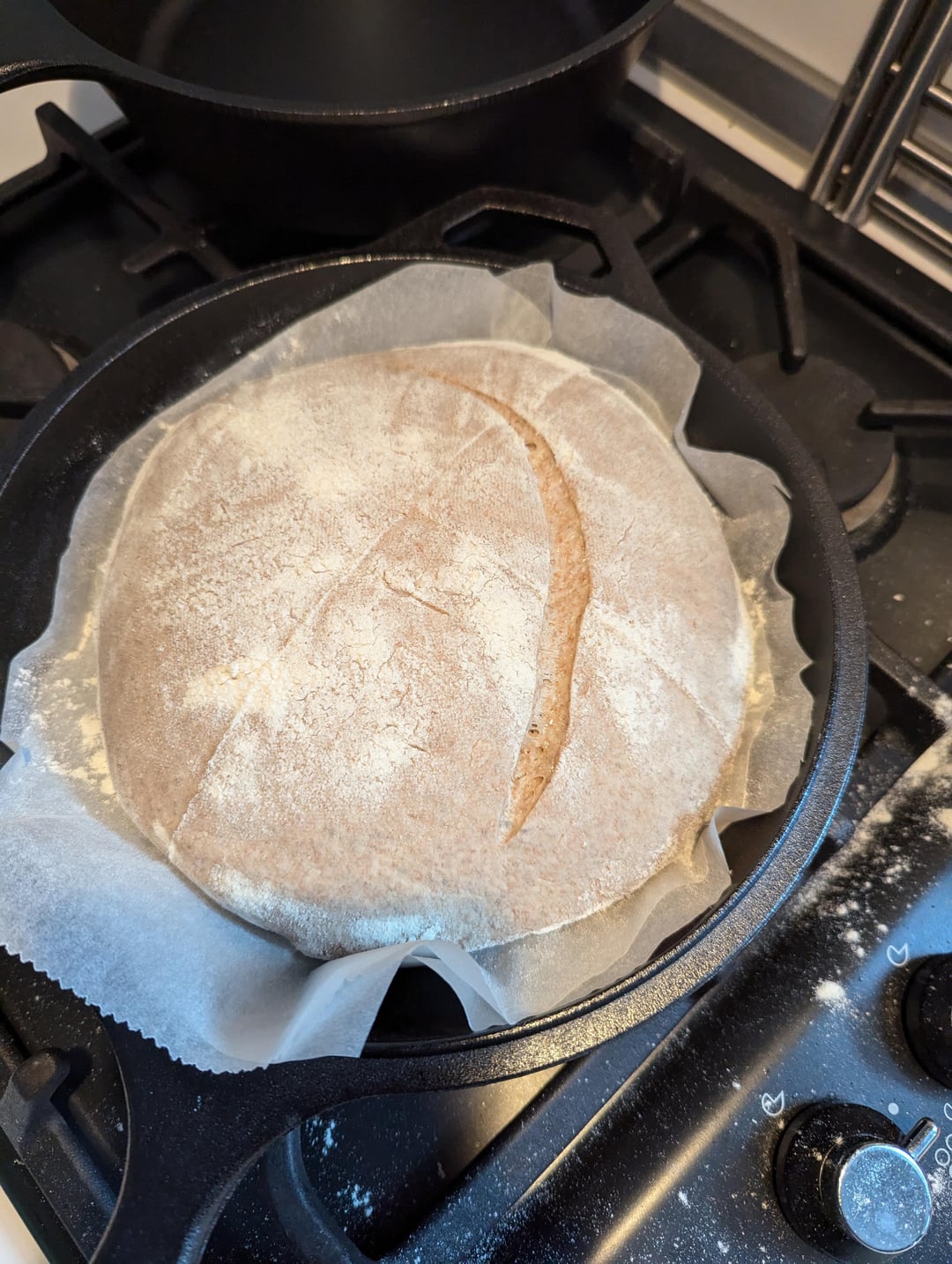
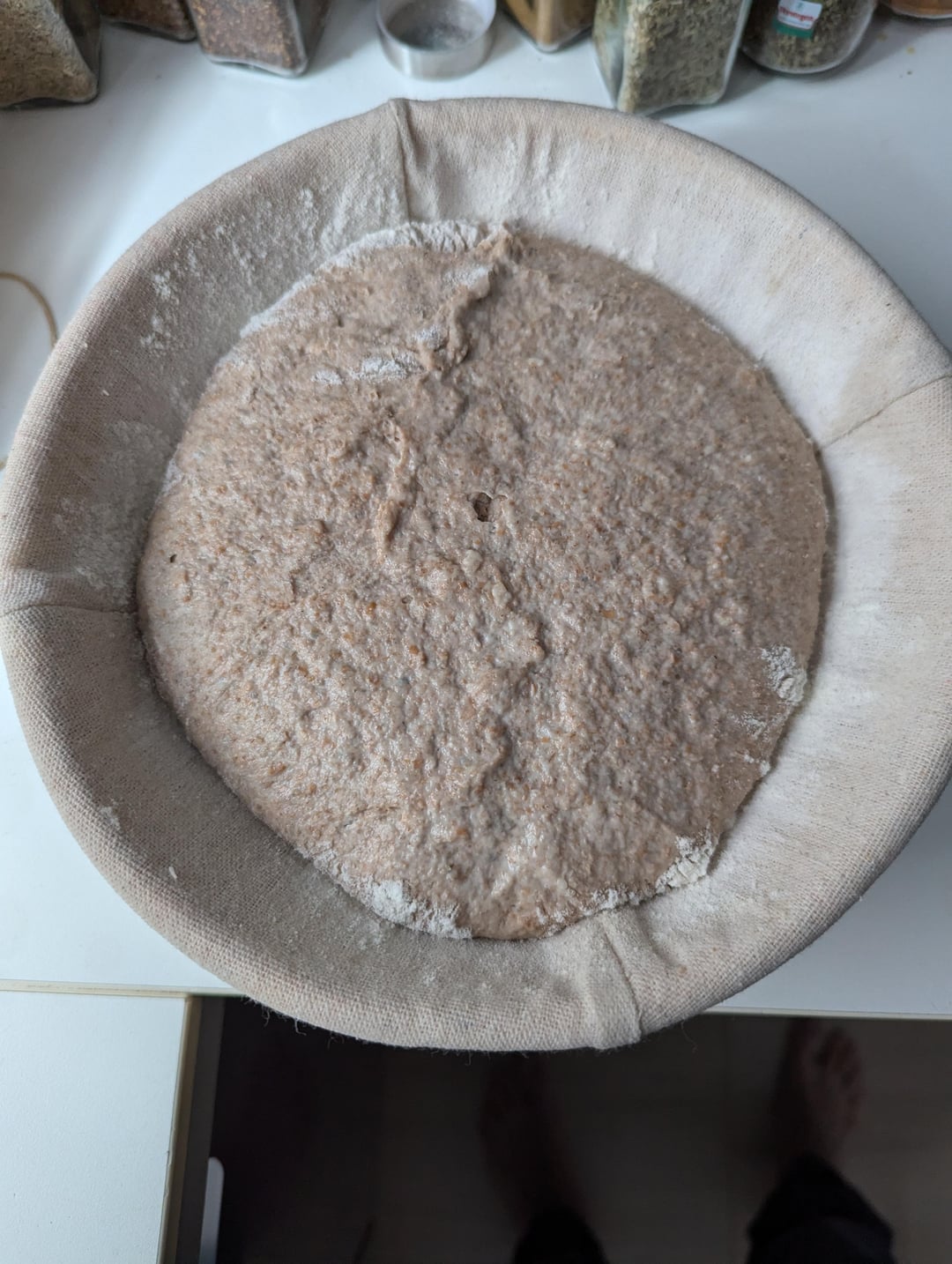
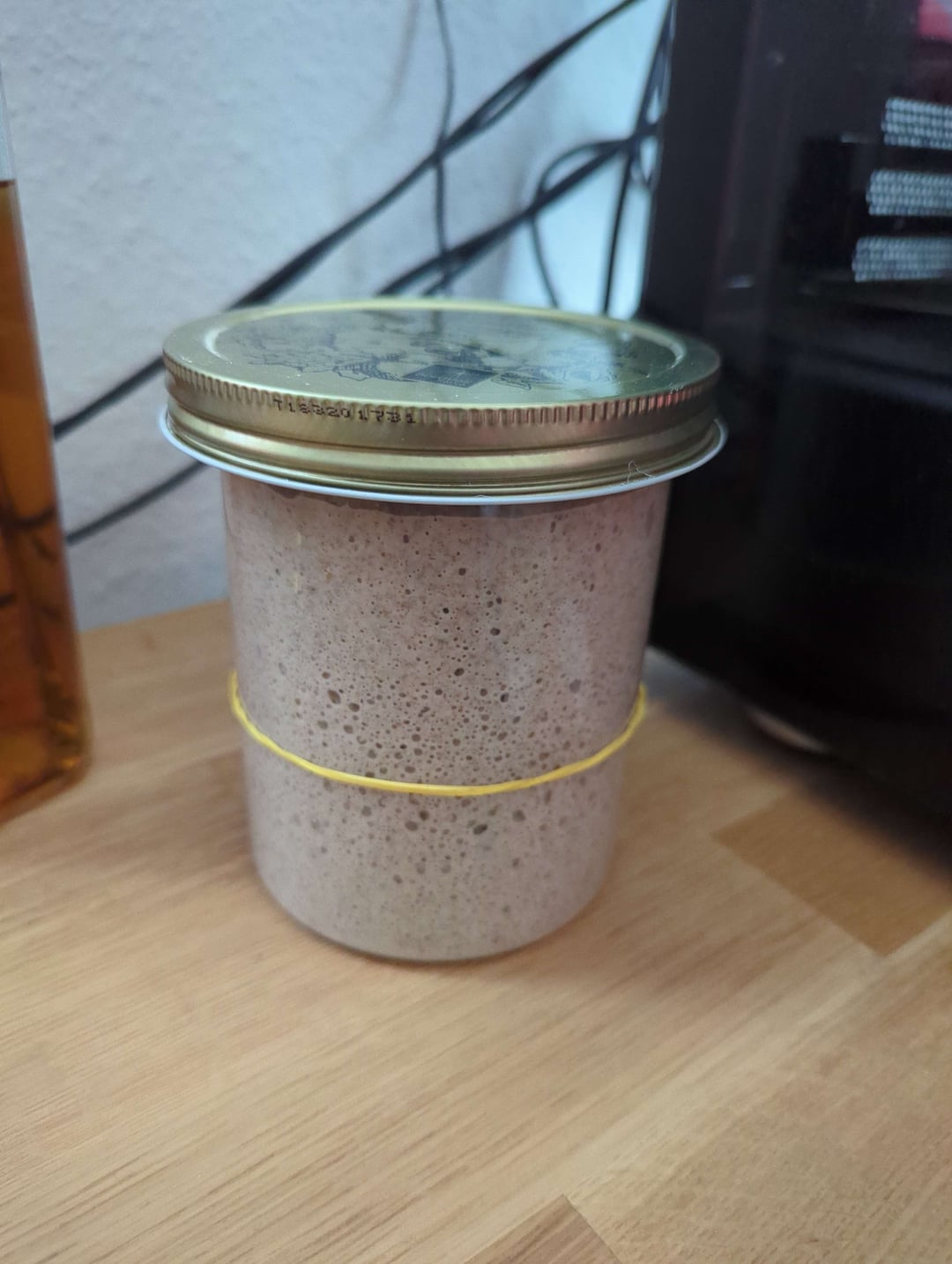
Hey all! Here's my first bread, and here is the recipe (guideline). I think for a very first attempt it came out well, obviously not perfect so would love to here feedback and tips 😁
500 grams of biological whole grain flour (80% whole grain spelt, 20% whole grain rye)
375 grams of water
100 grama of starter
7 grama of salt
And 75% or 95% hydration? Before baking the bread I thought it was 75%, but while stretching and folding and shaping I felt like maybe it's 95% due to the difficulty and stickyness (more on this below).
Fed the starter 7 hours before making the flour (starter is made of whole wheat rye flour), 15 minutes ish after the peak (I saw it starting to deflate) I got a 100 grams of starter out, and fed the new starter 1:1:1. Currently the starter is two weeks old, but it doubles in 6-8 hours, almost triples… living room currently sits at 23° C day and night due to summer.
Added 375 grams of water at 25° C. Mixed this with the 100 grams of starter and stirred it, to mix it with the water.
Added 400 grams (80%) of whole wheat spelt flour and 100 grams (20%) whole wheat rye flour and 7 grams of salt to a seperate bowl and mixed it all together.
Tossed the water starter mix into the bowl of flour and mixed it well together for a couple of minutes and let it rest for an hour. Put a plastic cover over the bowl while it rests.
60 minutes later…
Cleaned hands, wet hands and stretched and folded the flour 4 times every 90° and covered the sourdough again and waited 30 minutes, let it rest in the kitchen at 23° C.
[Repeated the above steps 5 times, but last three times I also did the rubaud mixing method after the folds]
Now, in total it sat for about 5 hours at room temperature (23° C) and now I've started shaping it. I used all purpose flower during this process and put it in its basked and popped it in the fridge overnight at 4° C. I thought I had 75% hydration, but I am starting to think I had to count the starter with it, making it 95% hydration, correct? Because it was extremely sticky and difficult to work with, like it was not fun… I did manage to get tension on the dough somehow but I'm definitely going to lower the water amount next time because I found it a bit stressful I have to say. With a wet finger, if I gently poked the dough, it slowly popped back up.
After 9.5 – 10 hours in the fridge I took it out, let it chill at room temperature (22° C) for 1 hour while the oven pre-heats the cast iron Lodge combo cooker at 250° C. The dough continued to grow in size overnight, but I don't need a wet finger to poke it at this point. It's tiny bit sticky, but bounced back without sticking, and it smells a bit like yoghurt (very faint).
I've then put two layers of baking paper in the pot and put the bread in it (flipped) and cut it at a 45° angle and put in the oven for 20 minutes at 250° C with the lid on.
After 20 minutes I reduced the temperature to 220° C and removed the lid for another 20 minutes. Then I took it out and checked the temperature inside, this was 99.4° C. The outside was nice and brown, so considered it done, and let it cool on a wire rack for 1 hour.
I have never baked bread before, so I'm completely new to this, except for during the pandemic I started making my own pizzas, so I do have a tiny bit of experience handling dough. But the whole process I find hard and difficult, so I would really appreciate any helps/tips possible. I tried to read and look-up many many videos the past couple of weeks, to try and absorb as much information as possible.
The starter used to smell alcoholic, but now it has a mix of yoghurt / vinegar and yeast smell. Even the bread before putting it in the oven smelled more like yoghurt. So currently what I'm trying is to do a refeed everytime it starts to deflate, which is feeding 2 times per day, and go from 1:1:1 to 1:2:2 because that should fix it? And at night before going to bed I started putting my starter in the fridge since yesterday because else the it has 15+ hours after its last feeding and from my understanding it gets too sour then from the bacteria which is not good for the yeast… right?
Any tips on creating a good balance on the starter is more than welcome – and same for the bread process!
Oh and the bread did taste great too 😊 miles better than store bought.
by Rlaan

3 Comments
Nice! Looks pretty tasty
I’d recommend using a sourdough calculator to work out your recipe. Start with 65% hydration, 20% starter, 2% salt. Those percentages are based on the flour weight (so 500g flour and 100g starter is 20%, but you’d need 10g salt to have 2% salt).
Wholemeal bread is more difficult to make than white so you might want to try with white first or just 10% Wholemeal.
It’s hard to tell much from the crumb for me – I think that’s because your dough is very wet and because of that you won’t have been able to build up as much gluten strength. That means it’s more liable to spread.
I’d definitely try with less water and see where you are
Looks great, i havent come even close to that resultat with my 100% wholegrain attemps